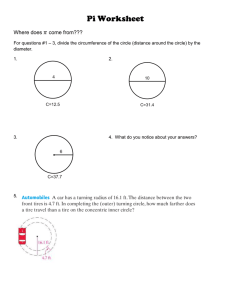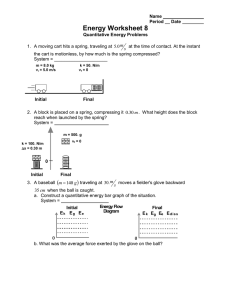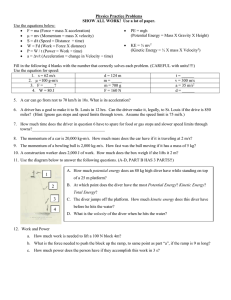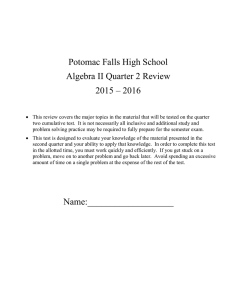Using Digital Video Analysis in Introductory Mechanics Projects
advertisement
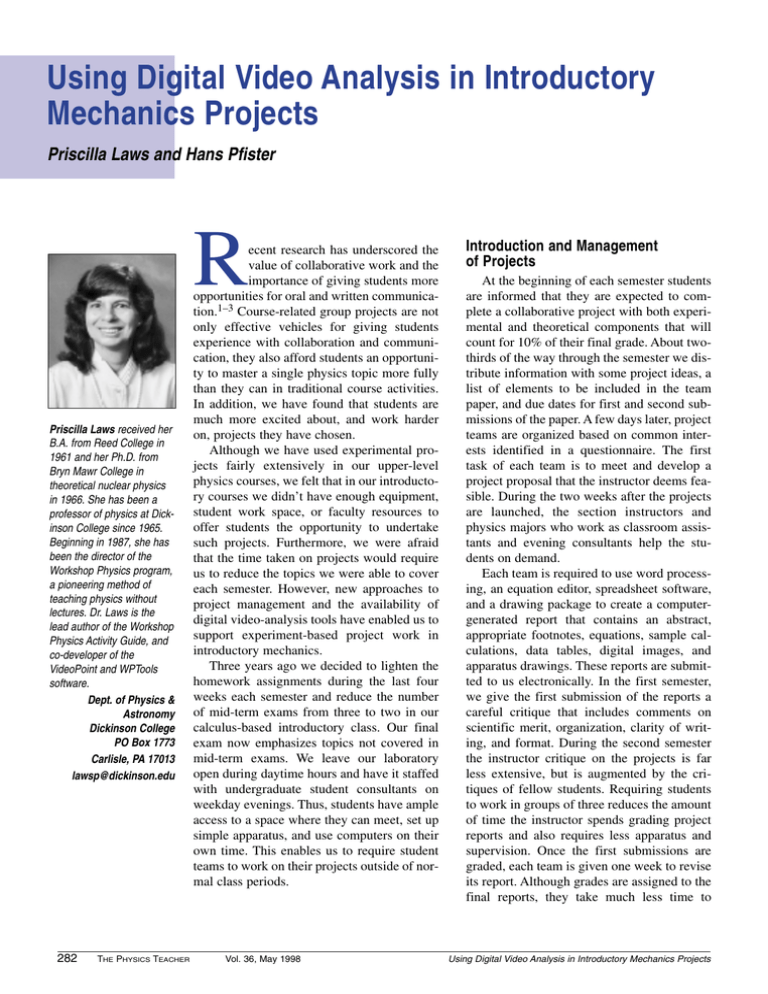
Using Digital Video Analysis in Introductory Mechanics Projects Priscilla Laws and Hans Pfister R Priscilla Laws received her B.A. from Reed College in 1961 and her Ph.D. from Bryn Mawr College in theoretical nuclear physics in 1966. She has been a professor of physics at Dickinson College since 1965. Beginning in 1987, she has been the director of the Workshop Physics program, a pioneering method of teaching physics without lectures. Dr. Laws is the lead author of the Workshop Physics Activity Guide, and co-developer of the VideoPoint and WPTools software. Dept. of Physics & Astronomy Dickinson College PO Box 1773 Carlisle, PA 17013 lawsp@dickinson.edu 282 THE PHYSICS TEACHER ecent research has underscored the value of collaborative work and the importance of giving students more opportunities for oral and written communication.1–3 Course-related group projects are not only effective vehicles for giving students experience with collaboration and communication, they also afford students an opportunity to master a single physics topic more fully than they can in traditional course activities. In addition, we have found that students are much more excited about, and work harder on, projects they have chosen. Although we have used experimental projects fairly extensively in our upper-level physics courses, we felt that in our introductory courses we didn’t have enough equipment, student work space, or faculty resources to offer students the opportunity to undertake such projects. Furthermore, we were afraid that the time taken on projects would require us to reduce the topics we were able to cover each semester. However, new approaches to project management and the availability of digital video-analysis tools have enabled us to support experiment-based project work in introductory mechanics. Three years ago we decided to lighten the homework assignments during the last four weeks each semester and reduce the number of mid-term exams from three to two in our calculus-based introductory class. Our final exam now emphasizes topics not covered in mid-term exams. We leave our laboratory open during daytime hours and have it staffed with undergraduate student consultants on weekday evenings. Thus, students have ample access to a space where they can meet, set up simple apparatus, and use computers on their own time. This enables us to require student teams to work on their projects outside of normal class periods. Vol. 36, May 1998 Introduction and Management of Projects At the beginning of each semester students are informed that they are expected to complete a collaborative project with both experimental and theoretical components that will count for 10% of their final grade. About twothirds of the way through the semester we distribute information with some project ideas, a list of elements to be included in the team paper, and due dates for first and second submissions of the paper. A few days later, project teams are organized based on common interests identified in a questionnaire. The first task of each team is to meet and develop a project proposal that the instructor deems feasible. During the two weeks after the projects are launched, the section instructors and physics majors who work as classroom assistants and evening consultants help the students on demand. Each team is required to use word processing, an equation editor, spreadsheet software, and a drawing package to create a computergenerated report that contains an abstract, appropriate footnotes, equations, sample calculations, data tables, digital images, and apparatus drawings. These reports are submitted to us electronically. In the first semester, we give the first submission of the reports a careful critique that includes comments on scientific merit, organization, clarity of writing, and format. During the second semester the instructor critique on the projects is far less extensive, but is augmented by the critiques of fellow students. Requiring students to work in groups of three reduces the amount of time the instructor spends grading project reports and also requires less apparatus and supervision. Once the first submissions are graded, each team is given one week to revise its report. Although grades are assigned to the final reports, they take much less time to Using Digital Video Analysis in Introductory Mechanics Projects Fig. 1. Stick figure on right illustrates how data needed to estimate location of center of mass can be obtained by idealizing a human as a collection of point masses. review because the reports are usually considerably better and because we do not feel that a detailed critique is as important. The team grade on the project is the average of the two grades assigned to the report. Instructors often shy away from assigning group grades because one student might not contribute as much as another. We ask each member of a team to complete a confidential questionnaire describing the contributions of each team member and estimating what percentage each contributed to the overall success of the project.4 Although about twothirds of the teams report equal contributions to projects, the questionnaire information is used to adjust individual project grades, if needed. Advantages of Video-Analysis Projects Digital video capture and analysis has a number of virtues. At present it is one of the few readily accessible methods for doing quantitative studies of electrostatics,5 thermal phenomena, and two-dimensional motions that are not too fast to be recorded at 30 frames per second. Based on studies of the educational benefits of video analysis6,7 and on our own experiences teaching Workshop Physics, we have incorporated video capture and analysis into our in-class activities.8 Homework assignments have been developed to give students experience analyzing videos of both laboratory-based and “real world” events.9 Because they have grown up with video technology, some of our students devise projects involving both video photography and analysis. Other students design projects that involve digitizing segments of commercial videotapes, educational videodisks, and scenes recorded from TV using a VCR. Although it is inappropriate to use commercial video materials for class demonstrations Using Digital Video Analysis in Introductory Mechanics Projects and homework assignments, a small project group can legally digitize a few frames of a commercial videotape that has been rented or purchased. This is considered to be fair use. A major advantage of computer-based video analysis is ease of use. When students use analysis software to scale video frames and locate points of interest frame-by-frame, they are required to make judgments and understand the analysis process. In addition, video software takes a great deal of the tedium out of recording data and frees students to concentrate on the physical phenomena under study. Another advantage is that position measurements made by video-analysis software on video images tend to have less relative uncertainty than other types of measurements made in introductory laboratories. Distances are measured in pixels (short for picture elements) and then scaled into real meters using an object of known length found in the image. Standard digital images are currently 320 pixels wide by 240 pixels tall, so uncertainties in position measurements are only about 1%. There is a wealth of video material showing motions that occur outside the laboratory: NASA launches, sports events, dance performances, movie stunts, and cartoons. Until recently video segments of such motions were often difficult to analyze if the camera was wobbling, panning, or zooming. The capabilities of the VideoPoint®10 analysis software package allows students to compensate for zooming and camera motion as long as the motion being analyzed lies in a plane perpendicular to the camera axis. Video-analysis programs can also be configured to calculate the center of mass of a system of objects, or a nonrigid object, based on assigned masses of system elements. One of the most popular features of video-analysis software used in human-motion studies has Vol. 36, May 1998 Hans Pfister received his staatsexam (M.S.) in math in 1978 and in physics in 1979 from Eberhard-Karls Universitat in Tubingen, Germany, and his Ph.D. in physics from UCLA in 1991. He began teaching at Dickinson College in 1991, and is currently an associate professor there. He is involved in the development of various kinds of kinesthetic apparatus that allow the incorporation of students into physics experiments enabling them to experience forces, acceleration, etc. on their own bodies. He is also involved in basic plasma physics research. Dept. of Physics & Astronomy Dickinson College PO Box 1773 Carlisle, PA 17013 pfister@dickinson.edu THE PHYSICS TEACHER 283 Projectile Motion of Leaping Humans Students enjoy filming each other engaging in a favorite activity or analyzing videos involving the motions of accomplished athletes or dancers. The analysis of leaps such as the grand jeté in ballet, the basketball slam dunk, and forward dives often prove quite interesting. In the case of the jeté and the dunk, the performer’s legs rise relative to the Fig. 2. Three frames showing wide receiver (black shirt) catching a pass in midair and defender (white shirt) jumping up and colliding with receiver. trunk during the leap so the head seems to float for a short period of time, giving the illusion of defying gravity. Further been the built-in center-of-mass calculation. Both analysis shows that, within the limits of measurement VideoPoint and VideoGraph11 software have incoruncertainty, the center of mass of a leaping person always porated data for the percent mass of each body part for a moves in the classic parabolic path described by the laws typical male and typical female athlete. These data are of physics. Despite claims to the contrary, even Michael Jordan has not been found by our students to have any real obtained from biokinesiology studies. The software “hang time”! calculates the center-of-mass coordinates of a human by approximating each body part between joints as a point Linear Momentum Conservation in Colliding mass. This is shown in Fig. 1. This feature enables Football Players students to determine the center of mass of a person merely by estimating the location of the center of mass Students who have played football are often intrigued of body segments. with testing momentum conservation during collisions between players. This is usually difficult since players are Examples of Mechanics Projects often in contact with the ground during collisions and do Over the past three years our students have worked on not form an isolated system. One student team managed to video projects based on scenes they have recorded themidentify a video segment showing a mid-air collision selves or obtained from other sources. Many projects cenbetween a wide receiver leaping to catch a pass and a ter on human body motions, cartoons, movies, and animal defender. Three of these frames are shown in Fig. 2. activities such as hummingbird hovering. Other examples Ideally the plane of motion of the players should be perare bungee jumping, swimming turns, parachute motions, pendicular to the camera axis. In this case the players are drag car trails, bottle rocket launches, and billiard ball moving toward the camera and appear to grow larger in motions. each frame. The students used the VideoPoint frame-by- Fig. 3. Digital video frames showing a reverse dive in which the student diver reconfigures himself from pike position to tuck position. 284 THE PHYSICS TEACHER Vol. 36, May 1998 Fig. 4. Idealized model of human body parts as rectangular slabs lying in the plane of motion. Video analysis determined dimensions of each slab and location of its center. The distance between the center of each slab and the center of mass of the athlete is used to calculate rotational inertia of diver. Using Digital Video Analysis in Introductory Mechanics Projects Table I. Summary of angular momentum data for a reverse dive. No. of Frames Diver’s Position Time Period (s) (rad/s) I (kg m2) L (kg m2/s) 6 tuck at top 0.24–0.41 8.99 4.72 42.4 5 final pike 0.81–0.94 2.95 14.4 42.4 frame rescaling feature and many hours of time to locate the center of mass of each player relative to a fixed point on the field. They determined the masses of the players by using professional football statistics and estimated the mass of their football gear based on information from a football supply catalog posted on the web. They found that the x-components of momenta before and after collision were the same within about 3% (with px initial = –7⫻104 kg m/s and px final = – 7.3⫻104 kg m/s). This is an unusually good result considering that there is at least a 1% or 2% uncertainty inherent in any position location used to locate body parts of each player and to rescale on each frame. Angular Momentum Conservation in Mid-Air Turns frame basis. After much wrestling with the problems and discussions with the instructors, both groups used basically the same approach. The analysis of the diving example illuminates the approach, which involves finding frame sequences in which the diver is almost a rigid body. In the first few frames after leaving the board, the diver is rotating slowly in a straight or pike position. A while later the diver has curled up into a tuck position and is rotating more rapidly (see Fig. 3). The students wanted to compare the angular momentum about the diver’s center of mass in the pike position with that of the tuck position by finding the rotational inertia and angular velocity of the diver in each configuration. Since angular momentum, L, for a rigid body can be determined as the product of rotational inertia, I, and angular velocity, , the project group needed to find I and for each position. The analysis began with a frame-byframe determination of the diver’s center of mass. By finding how a point on the diver in a pike position rotated relative to the center of mass and doing a similar analysis for the tuck position, the students found the angular velocities. The rotational inertia of the diver in each position Acrobats, cheerleaders, and divers are all able to turn in midair. Recently two rather ambitious student groups decided to track the center of mass of a turning human. They wanted to investigate whether angular momentum is conserved during the two-dimensional motion. One team worked on a video they made of two high dives performed by a member of the group. The other team analyzed the flip of a cheerleader tossed into the air. Although finding a parabolic path for the center of mass in each case is relatively straightforward, the investigation of angular momentum conservation is quite difficult. For example, as soon as a diver leaves the board he is continuously reconfiguring his body to go into a tuck position to achieve faster turns. In a similar manner, a cheerleader doing a flip goes into and then out of a jackknife position. When a body is nonrigid there is no stable axis about which to measure angular velocity. A second problem is that a method has to be devised to estimate the rotational inertia of a reconFig. 5. Two digital video frame sets from Tom-and-Jerry cartoons that depict falling motions. figuring body on a frame-by- Using Digital Video Analysis in Introductory Mechanics Projects Vol. 36, May 1998 THE PHYSICS TEACHER 285 motion to be quite realistic while the other violated physical laws. A pair of frames from each of these motions is shown in Fig. 5. 1. The falling vase. Since the average velocity of the vase seemed to be increasing from frame to frame, our students did a quadratic fit on the vertical position versus time (y-vs-t) data. By adjusting the scale so the table height was about 35 inches in the movie, the students obtained an excellent fit to their data (shown in Fig. 6). The fit gave the equation for y in meters as a function of time in seconds as Fig. 6. Vertical position-vs-time data for falling vase. was found by approximating each body part as a rectangle lying in the plane of motion. This is shown pictorially in Fig. 4. The rotational inertia of the ith body part, Ii, about its center is given by Ii = 1 ᎏᎏ 12 Mi (a 2i + b2i) where ai and bi are the dimensions of the rectangle. The parallel axis theorem is then used to find the rotational inertia, I i, of each rectangle about the diver’s center of mass. If the distance between the center of a rectangle and the diver’s center of mass is given by Ri, then the overall rotational inertia, I, of the diver is given by I = ⌺ (Ii + MR2i). Responding to the challenge of the project, team members spent a great deal of time on their investigations. They analyzed two different 3-m springboard dives—a 1½-turn forward dive and a 1-turn reverse dive with the diver entering the water feet first. Although the diver was constantly reconfiguring his body in both dives, he was in a more-or-less tuck configuration for several frames and then in a pike position just before entering the water with his arms in front of him pointing toward the water at about a 45o angle. The team was able to verify angular momentum conservation within 8% for a forward dive and, fortuitously, within less than 1% for a reverse dive. Results for the reverse dive are summarized in Table I. We recommend that this type of angular momentum conservation project be undertaken only by capable, highly motivated students. Cartoons and Movies Over the years, about a quarter of our students have chosen to work with motions depicted in their favorite cartoons and movies. The goal in most of these investigations was to show that the cartoon movies or stunts had been faked by finding instances in which the laws of physics are violated. Students are sometimes surprised to find that the movie motions are quite realistic. For example, analysis of two Tom-and-Jerry cartoon motions showed one 286 THE PHYSICS TEACHER Vol. 36, May 1998 y = (–4.90±0.33) t2 + (–0.26±0.14) t + (–0.28±0.012) m Thus the value for the y-component of acceleration of the vase is ay = 2 (–4.9± 0.3) = – 9.8 ± 0.6 m/s2. Given the consistency of the results with the free-fall equation, we might assume that the animator or an advisor had a physics background. 2. Jerry falling into milk. On the other hand, since the yvs-t data in sequence two of Fig. 5 turned out to be linear, Jerry fell at a constant velocity, an unrealistic situation that does not obey the laws of physics. We think it possible that animators sometimes use films of real events as a template for their drawings and at other times they don’t. Creating Digital Video Movies There are two steps to creating digital movies for use with VideoPoint or VideoGraph software. First, a video camera must be used to record a sequence of video frames or, alternatively, a video-frame sequence must be selected from existing videotapes or videodisks. Second, the frame sequence must be digitized using a capture system. There are many considerations in preparing to make digital videos that can be used for analysis of physical phenomena. These include how to set up a video-capture system, how to make movies with a video camera, and how to select good video sequences from existing materials. The Lenox Softworks website (www.lsw.com/videopoint) contains some excellent tips on digital moviemaking and capture. Additional information is available in the manuals that come with the VideoPoint and VideoGraph software. There are also a number of excellent videodisks and tapes with motions that can be digitized. These include: the AAPT Single Concept Film Collection;12 the Physics and Automobile Collision videodisk;13 and the Physics of Sport and Physics of Work videodisks.14 Conclusions Many students have commented that they learned more about mechanics from their projects than from other course-related activities. As instructors we feel that collaborative projects based on digital video analysis provide an educational, motivating, and cost-effective alternative Using Digital Video Analysis in Introductory Mechanics Projects to traditional course-related activities in introductory physics. In view of the effort that our student teams expend on projects and the learning that takes place, we recently decided to raise the grade allocation for projects from 10% to 15%. References 1. P. Heller, R. Keith, and S. Anderson, “Teaching problem solving through cooperative grouping. Part 1: Group versus individual problem solving,” Am J. Phys. 60, 627–636 (1992). 2. P. Heller and M. Hollabaugh, “Teaching problem solving through cooperative grouping. Part. 2: Designing problems and structuring groups,” Am J. Phys. 60, 637–644 (1992). 3. AIP Education and Employment Statistics Division, 1994 Sigma Pi Sigma Survey of “Skills Used Frequently by Physics Bachelors in Selected Employment Sectors, 1994.” 4. Private Communication; based on a suggestion by Patricia and Kenneth Heller of the University of Minnesota. 5. P. W. Laws, “Millikan Lecture 1996: Promoting active learning based on physics education research in introductory physics courses,” Am. J. Phys. 65, 13–21 (1997). 6. R. J. Beichner, “The impact of video motion analysis on kinematics graph interpretation skills,” Am. J. Phys. 64, 1272–1277 (1996). 7. L. T. Escalada and D. A. Zollman, “An investigation of the effects of using interactive digital video in a physics classroom on student learning and attitudes,” J. Res. Sci. Teach. 34, 467–489 (1997). 8. P. W. Laws, Workshop Physics Activity Guide (Wiley, New York, 1997). 9. These assignments can be downloaded from our website: http://physics.dickinson.edu. 10. VideoPoint,® designed for use with Windows and Macintosh operating systems, is published by Lenox Softworks and distributed by PASCO scientific (800772-8700). For more information, consult www.lsw.com/videopoint. 11. VideoGraph,® designed for use with Macintosh operating systems, is distributed by Physics Academic Software (800-955-8275). For more information, consult www.aip.org/pas. 12. Available from the AAPT (301-209-3300) or Ztek (502-584-8505). 13. Available from John Wiley & Sons (800-548-8505) or Ztek (502-584-8505). 14. Available from VideoDiscovery (800-548-3472). Using Digital Video Analysis in Introductory Mechanics Projects Vol. 36, May 1998 THE PHYSICS TEACHER 287
